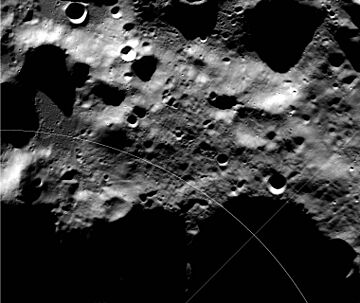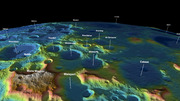Mons Mouton facts for kids
Quick facts for kids Mons Mouton |
|
|---|---|

LRO Wide Angle Camera mosaic
|
|
| Highest point | |
| Listing | Lunar mountains |
| Naming | |
| Etymology | Named for Melba Roy Mouton |
| English translation | Mouton Mountain |
| Language of name | Latin |
| Geography | |
| Location | the Moon |
Mons Mouton is the tallest mountain on the Moon that has been officially named. It's like a giant, flat-topped hill on our closest space neighbor.
This mountain is about 6 kilometers (almost 4 miles) tall from its base to its top. It's also quite wide, nearly 100 kilometers (about 62 miles) across! Mons Mouton is located very close to the Moon's South Pole. It sits between two craters called Nobile and Malapert.
Contents
Why Mons Mouton is Special
This area of the Moon is very interesting to scientists. It has places called Permanently Shadowed Regions (PSRs). These are spots where sunlight never reaches, so they are extremely cold. Scientists believe these cold spots might trap water ice. Close by, there are also areas that get a lot of sunlight. This mix of light and shadow makes the region perfect for future lunar missions.
Missions to Mons Mouton
Because of its unique features, Mons Mouton was chosen as a landing site for robotic missions.
The VIPER Rover
The Volatiles Investigating Polar Exploration Rover (VIPER) was a robot designed to look for water ice. It was planned to land on Mons Mouton. However, the VIPER mission was later canceled.
The IM-2 Athena Lander
After VIPER, Mons Mouton was selected as the landing spot for the IM-2 Athena lunar lander. This spacecraft landed on March 6, 2025.
IM-2 Landing Challenges
The IM-2 Athena spacecraft landed safely, but it ended up resting on its side. This made it harder for the mission to do all its planned science work. Something similar happened with the company's earlier spacecraft, Odysseus, in 2024.
On March 13, 2025, the company shared more details. The Athena lander's altimeter, which measures height, stopped working during the landing. This meant the computer didn't know how high it was. The spacecraft hit a raised area, tipped over, and slid across the Moon's surface. It rolled once or twice before stopping inside a crater. The company's CEO compared it to a baseball player sliding into a base. The impact also kicked up a lot of lunar dust, called regolith. This dust covered the solar panels, making it harder for them to create power.
How Mons Mouton Formed and Got Its Name
Scientists think Mons Mouton might be a leftover piece of the rim of a huge impact crater. This crater is called the South Pole–Aitken basin. It's one of the oldest, largest, and deepest craters in our Solar System. There are even taller mountains on the Moon's far side that are probably also part of this ancient basin, but they haven't been officially named yet.
Mons Mouton was sometimes called "Leibnitz Beta" before it got its official name. On May 13, 2022, it was named after Melba Roy Mouton. She was an American mathematician who worked on space missions.
Gallery



